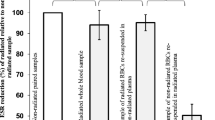Abstract
This study is designed to investigate in vitro low-level laser (LLL) effects on rheological parameter, erythrocyte sedimentation rate (ESR), of human blood. The interaction mechanism between LLL radiation and blood is unclear. Therefore, research addresses the effects of LLL irradiation on human blood and this is essential to understanding how laser radiation interacts with biological cells and tissues. The blood samples were collected through venipuncture into EDTA-containing tubes as an anticoagulant. Each sample was divided into two equal aliquots to be used as a non-irradiated sample (control) and an irradiated sample. The aliquot was subjected to doses of 36, 54, 72 and 90 J/cm2 with wavelengths of 405, 589 and 780 nm, with a radiation source at a fixed power density of 30 mW/cm2. The ESR and red blood cell count and volume are measured after laser irradiation and compared with the non-irradiated samples. The maximum reduction in ESR is observed with radiation dose 72 J/cm2 delivered with a 405-nm wavelength laser beam. Moreover, no hemolysis is observed under these irradiation conditions. In a separate protocol, ESR of separated RBCs re-suspended in irradiated plasma (7.6 ± 2.3 mm/h) is found to be significantly lower (by 51 %) than their counterpart re-suspended in non-irradiated plasma (15.0 ± 3.7 mm/h). These results indicate that ESR reduction is mainly due to the effects of LLL on the plasma composition that ultimately affect whole blood ESR.



Similar content being viewed by others
References
Karu T, Afanasyeva N, Kolyakov SF, Pyatibrat LV, Welser L (2001) Changes in absorbance of monolayer of living cells induced by laser radiation at 633, 670, and 820 nm. Selected Topics in Quantum Electronics, IEEE Journal of 7(6):982–988
Korolevich AN, Dubina NS, Vecherinski SI. Influence of low-intensity laser radiation on human blood microcirculation. In: BiOS 2000 The International Symposium on Biomedical Optics, 2000. International Society for Optics and Photonics, pp 175-179
Siposan DG, Lukacs A (2000) Effect of low-level laser radiation on some rheological factors in human blood: an in vitro study. J Clin Laser Med Surg 18(4):185–195
Liu X, Lu J, Wang Y, Ni X (1999) Physical analysis of intravascular low-reation-lever laser irradiation therapy on improving the hemorheologic characteristics. In: International Symposium on Biomedical Optics,. International Society for Optics and Photonics, pp 465-467
Karu TI (2003) Low-power laser therapy. Biomedical Photonics Handbook 48:1–25
Vladimirov YA, Osipov A, Klebanov G (2004) Photobiological principles of therapeutic applications of laser radiation. Biochemistry (Moscow) 69(1):81–90
Sutherland JC (2002) Biological effects of polychromatic light. Photochem Photobiol 76(2):164–170
Mi X-Q, Chen J-Y, Liang Z-J, Zhou L-W (2004) In vitro effects of helium-neon laser irradiation on human blood: blood viscosity and deformability of erythrocytes. Photomedicine Laser Therapy 22(6):477–482
Lin’kova N, Gorshkova O, Shuvaeva V, Dvoretskii D (2008) Effect of low-intensity laser radiation of the red spectrum on some properties of erythrocytes in Wistar rats. Bull Exp Biol Med 145(1):7–9
Yinghua C, Wenming X (2002) Mechanism analysis on ILIB improving the property of rheology of blood. Laser J 2:030
Ying HZH (1998) The studies of hemorheological indexes blood lipid and fibrinogen after the treatment of CVD with ILIB. Chin J Hemorheol 4:027
Sox HC, Liang MH (1986) Diagnostic decision: the erythrocyte sedimentation rate: guidelines for rational use. Ann Intern Med 104(4):515–523
Crawford J, Eye-Boland MK, Cohen HJ (1987) Clinical utility of erythrocyte sedimentation rate and plasma protein analysis in the elderly. Am J Med 82(2):239–246
Fabry TL (1987) Mechanism of erythrocyte aggregation and sedimentation. Blood 70(5):1572–1576
Bedell SE, Bush BT (1985) Erythrocyte sedimentation rate. From folklore to facts. Am J Med 78(6):1001–1009
Mostafa Y, Amin S, Abdalwahab S, Elsherbini A (2013) Effects of non-coherent and coherent light on complete blood picture and osmotic fragility of human blood. J Blood Disorders Transf 4:134
Siposan DG, Bobe S (2010) Effects of HeNe LASER on stored blood. Laser Therapy 19(4):245–255
Calabrese EJ (2001) The future of hormesis: where do we go from here? CRC Crit Rev Toxicol 31(4-5):637–648
Huang Y-Y, Chen AC-H, Carroll JD, Hamblin MR (2009) Biphasic dose response in low level light therapy. Dose-Response 7 (4):dose-response. 09-027. Hamblin
Musawi MSA, Jafar MS, Al-Gailani BT, Ahmed NM, Suhaimi F, Suardi N (2016) In vitro mean red blood cell volume change induced by diode pump solid state low-level laser of 405 nm. Photomed Laser Surg 36(5):1–4. doi:10.1089/pho.2015.4043
Sommer AP, Pinheiro AL, Mester AR, Franke R-P, Whelan HT (2001) Biostimulatory windows in low-intensity laser activation: lasers, scanners, and NASA’s light-emitting diode array system. J Clin Laser Med Surg 19(1):29–33
Wang W-C (1986) Electromagnetic wave theory.
Reinhart W (1995) Hemorheology: blood flow hematology. Schweiz Med Wochenschr 125(9):387–395
Stoltz J, Donner M (1990) New trends in clinical hemorheology: an introduction to the concept of the hemorheological profile. Schweiz Med Wochensch Suppl 43:41–49
Brigden ML (1999) Clinical utility of the erythrocyte sedimentation rate. Am Fam Physician 60(5):1443–1450
Ghadage V, Kulkarni G (2010) Effects of Nd: YAG laser irradiation on human erythrocytes in vitro. Int J Integr Biol 9(3):149–151
Genkin V, Novikov V, Paramonov L, El’kina B (1989) Effects of low-intensity laser irradiation on the state of blood proteins. Biulleten’eksperimental’noi biologii i meditsiny 108(8):188–190
Siposan DG, Lukacs A (2001) Relative variation to received dose of some erythrocytic and leukocytic indices of human blood as a result of low-level laser radiation: an in vitro study. J Clin Laser Med Surg 19(2):89–103
de Souza da Fonseca A, Presta G, Geller M, de Paoli F, Valença S (2012) Low-intensity infrared laser increases plasma proteins and induces oxidative stress in vitro. Lasers Med Sci 27(1):211–217. doi:10.1007/s10103-011-0945-7
Sommer AP, Haddad MK, Fecht H-J (2015) Light effect on water viscosity: implication for ATP biosynthesis. Sci Rep 5:12029
Author information
Authors and Affiliations
Corresponding author
Rights and permissions
About this article
Cite this article
Al Musawi, M.S., Jaafar, M.S., Al-Gailani, B. et al. Erythrocyte sedimentation rate of human blood exposed to low-level laser. Lasers Med Sci 31, 1195–1201 (2016). https://doi.org/10.1007/s10103-016-1972-1
Received:
Accepted:
Published:
Issue Date:
DOI: https://doi.org/10.1007/s10103-016-1972-1




